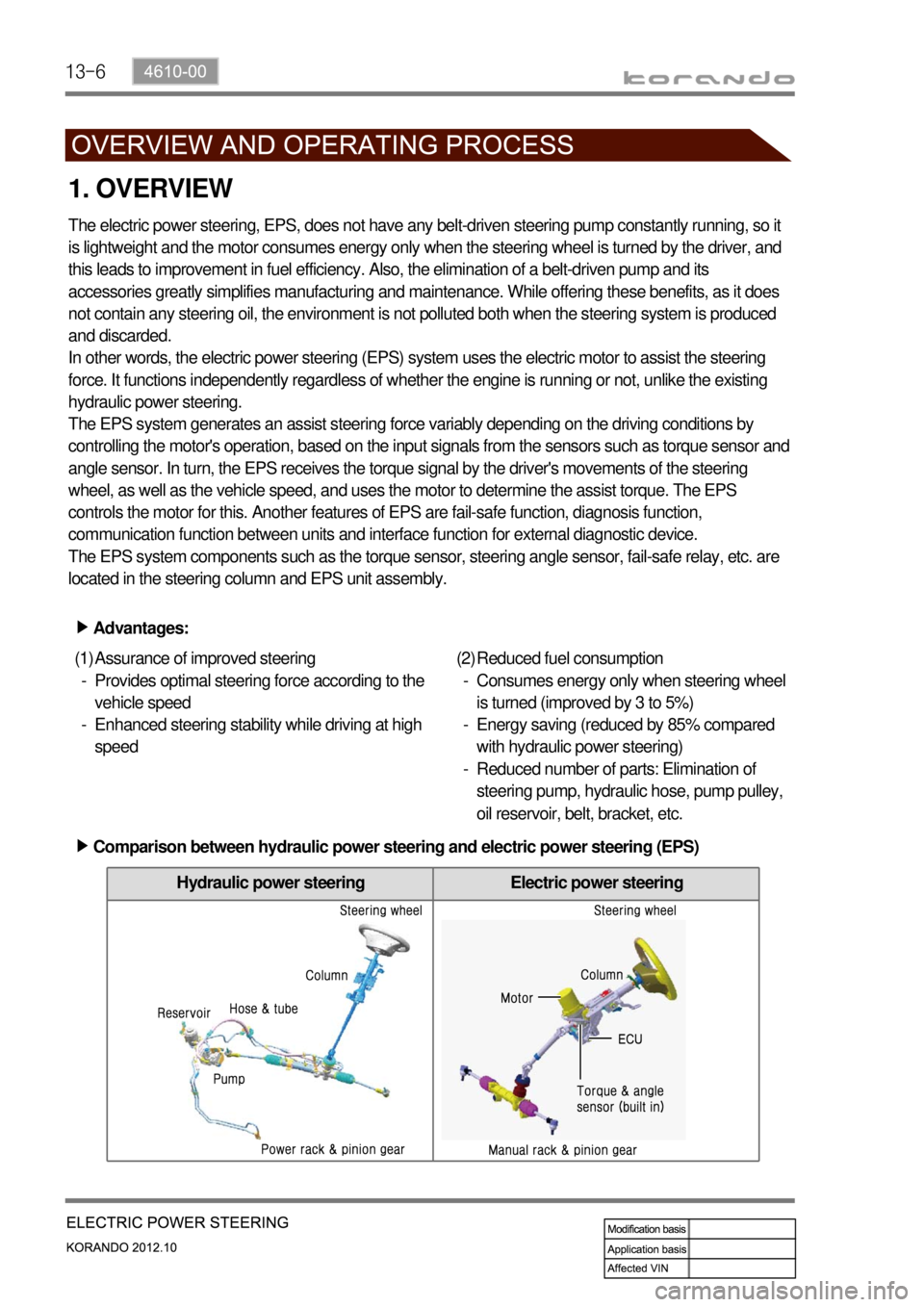Page 396 of 1082
03-6
Returnless Type
1. OVERVIEW
The fuel system is a returnless type that the fuel pressure regulator is mounted inside the fuel tank.
The engine ECU controls the fuel injection in each injector electronically.
According to the engine loads, the engine ECU draws or cuts off the evaporated gas in canister into the
combustion chamber. The fuel system consists of fuel tank, fuel lines, fuel pump and fuel pressure
regulator.
Fuel supply line to
sub tank
Fuel return lineFuel supply line
Maintain 3.8 bar
Page 398 of 1082
03-8
Fuel pump and fuel sender assembly
2. COMPONENTS
CanisterFuel filter
Fuel tank assembly
Primary fuel
sender
Fuel tank assembly
Fuel neck hose
CanisterFuel filter
Page 494 of 1082
01-6
2. SPECIFICATION
DescriptionDiesel 2.0 Engine
(D20DTF(Low CO2))
General Overall length (mm) 4,410 (4,500: with trailer hitch)
Overall width (mm) 1,830
Overall height (mm) 1,675
Gross vehicle
weight (kg)M/T 4WD : 2,065(2,110)
2WD : 1,905(1,920)
Curb vehicle
weight (kg)M/T 4WD : 1,740(1,785)
2WD : 1,580(1,595)
Fuel Diesel
Fuel tank capacity (ℓ)57
Engine Engine D20DTF
Number of cylinders/ Compression ratio 4 / 16.5:1
Total displacement (cc) 1,998
Camshaft arrangement DOHC
Max. power M/T 149 ps / 4,000 rpm
Max. torque 360 Nm / 1,500~2,800 RPM
Idle speed750 ± 20 rpm
Cooling system Water-cooled / forced circulation
Coolant capacity (ℓ)8.5
Lubrication type Gear pump, forced circulation
Max. oil capacity (ℓ)6.0
Turbocharger and cooling type Turbocharger, water-cooled
Page 989 of 1082

13-6
Hydraulic power steering Electric power steering
1. OVERVIEW
The electric power steering, EPS, does not have any belt-driven steering pump constantly running, so it
is lightweight and the motor consumes energy only when the steering wheel is turned by the driver, and
this leads to improvement in fuel efficiency. Also, the elimination of a belt-driven pump and its
accessories greatly simplifies manufacturing and maintenance. While offering these benefits, as it does
not contain any steering oil, the environment is not polluted both when the steering system is produced
and discarded.
In other words, the electric power steering (EPS) system uses the electric motor to assist the steering
force. It functions independently regardless of whether the engine is running or not, unlike the existing
hydraulic power steering.
The EPS system generates an assist steering force variably depending on the driving conditions by
controlling the motor's operation, based on the input signals from the sensors such as torque sensor and
angle sensor. In turn, the EPS receives the torque signal by the driver's movements of the steering
wheel, as well as the vehicle speed, and uses the motor to determine the assist torque. The EPS
controls the motor for this. Another features of EPS are fail-safe function, diagnosis function,
communication function between units and interface function for external diagnostic device.
The EPS system components such as the torque sensor, steering angle sensor, fail-safe relay, etc. are
located in the steering column and EPS unit assembly.
Advantages: ▶
Assurance of improved steering
Provides optimal steering force according to the
vehicle speed
Enhanced steering stability while driving at high
speed (1)
-
-Reduced fuel consumption
Consumes energy only when steering wheel
is turned (improved by 3 to 5%)
Energy saving (reduced by 85% compared
with hydraulic power steering)
Reduced number of parts: Elimination of
steering pump, hydraulic hose, pump pulley,
oil reservoir, belt, bracket, etc. (2)
-
-
-
Comparison between hydraulic power steering and electric power steering (EPS) ▶